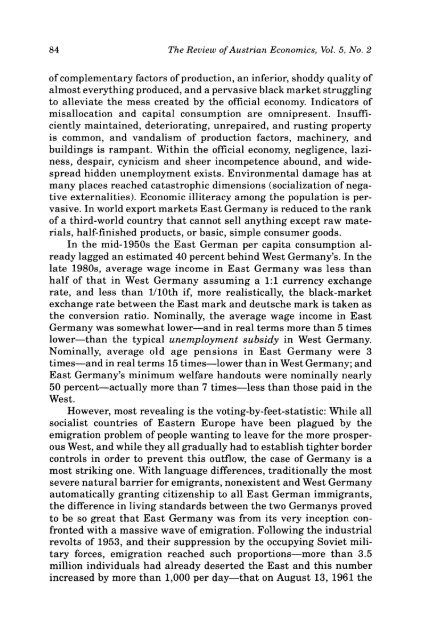Review of Austrian Economics - The Ludwig von Mises Institute
Review of Austrian Economics - The Ludwig von Mises Institute
Review of Austrian Economics - The Ludwig von Mises Institute
You also want an ePaper? Increase the reach of your titles
YUMPU automatically turns print PDFs into web optimized ePapers that Google loves.
84 <strong>The</strong> <strong>Review</strong> <strong>of</strong> <strong>Austrian</strong> <strong>Economics</strong>, Vol. 5, No. 2<br />
<strong>of</strong> complementary factors <strong>of</strong> production, an inferior, shoddy quality <strong>of</strong><br />
almost everything produced, and a pervasive black market struggling<br />
to alleviate the mess created by the <strong>of</strong>ficial economy. Indicators <strong>of</strong><br />
misallocation and capital consumption are omnipresent. Insufficiently<br />
maintained, deteriorating, unrepaired, and rusting property<br />
is common, and vandalism <strong>of</strong> production factors, machinery, and<br />
buildings is rampant. Within the <strong>of</strong>ficial economy, negligence, laziness,<br />
despair, cynicism and sheer incompetence abound, and widespread<br />
hidden unemployment exists. Environmental damage has at<br />
many places reached catastrophic dimensions (socialization <strong>of</strong> negative<br />
externalities). Economic illiteracy among the population is pervasive.<br />
In world export markets East Germany is reduced to the rank<br />
<strong>of</strong> a third-world country that cannot sell anything except raw materials,<br />
half-finished products, or basic, simple consumer goods.<br />
In the mid-1950s the East German per capita consumption already<br />
lagged an estimated 40 percent behind West Germany's. In the<br />
late 1980s, average wage income in East Germany was less than<br />
half <strong>of</strong> that in West Germany assuming a 1:1 currency exchange<br />
rate, and less than l/10th if, more realistically, the black-market<br />
exchange rate between the East mark and deutsche mark is taken as<br />
the conversion ratio. Nominally, the average wage income in East<br />
Germany was somewhat lower—and in real terms more than 5 times<br />
lower—than the typical unemployment subsidy in West Germany.<br />
Nominally, average old age pensions in East Germany were 3<br />
times—and in real terms 15 times—lower than in West Germany; and<br />
East Germany's minimum welfare handouts were nominally nearly<br />
50 percent—actually more than 7 times—less than those paid in the<br />
West.<br />
However, most revealing is the voting-by-feet-statistic: While all<br />
socialist countries <strong>of</strong> Eastern Europe have been plagued by the<br />
emigration problem <strong>of</strong> people wanting to leave for the more prosperous<br />
West, and while they all gradually had to establish tighter border<br />
controls in order to prevent this outflow, the case <strong>of</strong> Germany is a<br />
most striking one. With language differences, traditionally the most<br />
severe natural barrier for emigrants, nonexistent and West Germany<br />
automatically granting citizenship to all East German immigrants,<br />
the difference in living standards between the two Germanys proved<br />
to be so great that East Germany was from its very inception confronted<br />
with a massive wave <strong>of</strong> emigration. Following the industrial<br />
revolts <strong>of</strong> 1953, and their suppression by the occupying Soviet military<br />
forces, emigration reached such proportions—more than 3.5<br />
million individuals had already deserted the East and this number<br />
increased by more than 1,000 per day—that on August 13, 1961 the

















